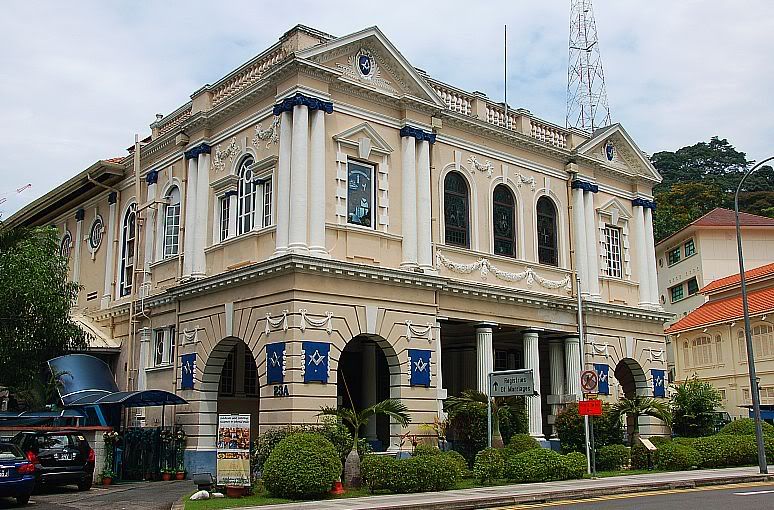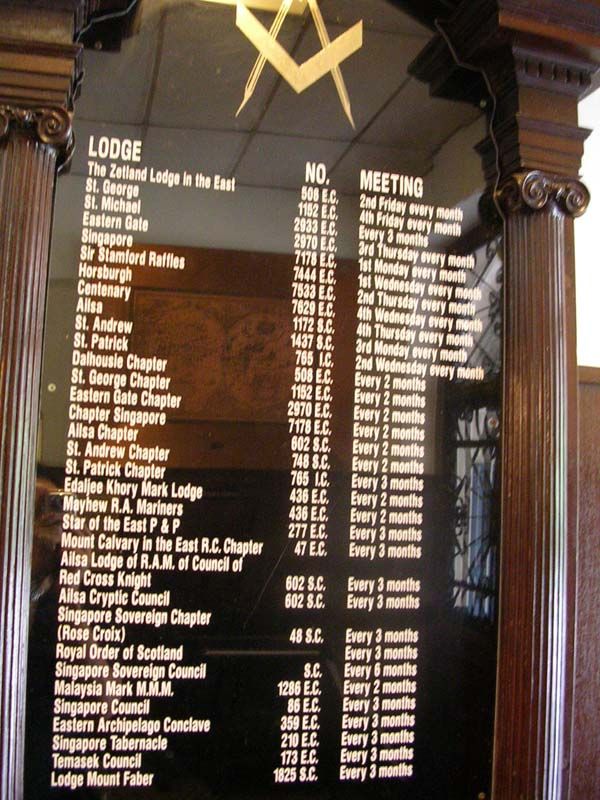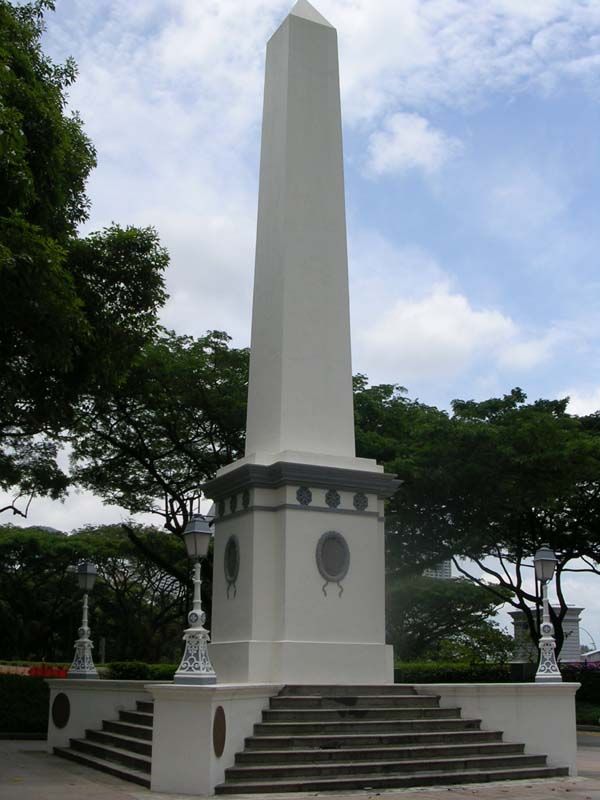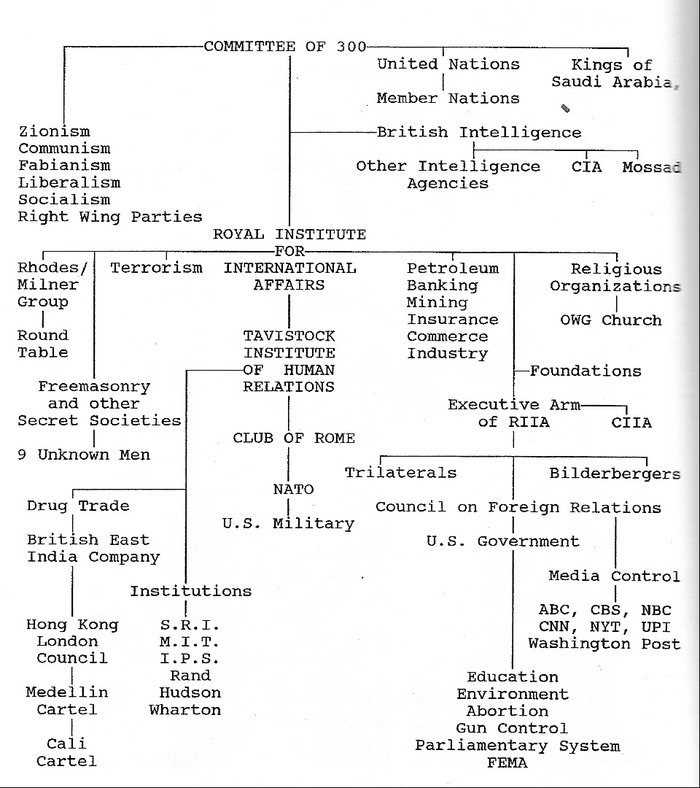- Joined
- Aug 29, 2008
- Messages
- 27,358
- Points
- 113
Always pass by this building on my way to a client's...
Anybody here is a member? How can I join?

Anybody here is a member? How can I join?


You would have to be invited by a lodge member.
Can I be invited by a lodge member from about country? Are lodges from different countries affiliated?

Singapore: Masonic Paradise?
This post speculates that the city-state of Singapore may secretly have been planned out by Freemasonry and be under masonic or semi-masonic rule to this day.
Whether this secret rule (if it exists) is "good" or "bad" is, as you will see, a matter of worldview. Both masons and anti-masonic-conspiracy-theorists could easily use this to support their views, depending upon whether one views unrestrained capitalism as "good" or "bad".
Singapore is arguably the richest, safest, cleanest places on earth. It is also one of the only known "benevolent dictatorship" (only semi-democratic) in the History of mankind. 42% of its population are practicing Buddhists, the rest are mainly Christians, Muslims and Jews.

After getting a "hint" from a Veteran-Freemason about the importance of Freemasonry in Singapore, I did a little bit of research. The first oddity I noticed was the high number of lodges:

Thats 35 lodges in a single city (meeting in one lodge building, there could be more) - which is rather anomalous.
Next I found out that much of the ruling elite of Singapore were Freemasons. The Founder of Singapore, Sir Stamford Raffles, was a Freemason. A few others:
Source
These fellow Singaporean Freemasons or Brothers are:-
Sir Charles Warren – Commissioner of Police of the Metropolis
Thomas Dunman - Deputy Superintendent of Police
Thomas Braddell – First Attorney General of Singapore
James Brooke - Rajah of Sarawak
Sir Henry Keppel – Admiral of the Fleet
William Henry Macleod Read – Chairman of the Singapore Chamber of Commerce
The "Marquis of Dalhousie", one of the most influential figures of British Colonialism was a Freemason. An Obelisk was erected in his honour - in Singapore:

The Turbo-Capitalistic mentality of Singapore might be explained by the following inscription on the Obelisk (partially quoted):
“emphatically recognized the wisdom of liberating commerce from all restraints, under which enlightened policy this settlement has rapidly attained its present rank among British possessions and with which its future prosperity must ever be identified”
The designer of the Obelisk and author of the inscription, John Turnbull Thomson, was also a Freemason.
___________________________________________________
I found a more recent article on Singapore being run by secret societies in the "China Morning Post". The article is about Singapores semi-masonic "Pyramid Club"
Relevant snippets:
the more important but least-familiar parts of Singapore's formidably successful establishment. The Pyramid is the after-hours home for more than 300 of the country's top movers and shakers, and anyone who is anyone is said to be a member.Although the Pyramid's membership list might read like a Who's Who of Singapore, the institution goes out of its way not to attract attention.One well-placed Singaporean talks of the Pyramid in terms that most people would associate with a cult. He speculates on understandings forged within a cosy fraternity and designed to keep the country on its stable trajectory. The reality is perhaps less sensational but might help in understanding formation and execution of Singapore's public policy.George Yeo Yong-Boon, the Minister for Trade and Industry and one of the Government's most promising front-benchers, is the Pyramid's president, assisted by vice-president Mah Bow Tan, who is the Minister for National Development. Michael Lim Choo San, the chairman of the National Healthcare Group, which manages half of the island's hospitals and clinics, is listed as honorary treasurer.The first club president was Goh Keng Swee - a key ally of then-prime minister Lee - who then held the finance-ministry portfolio. He was supported by Pyramid vice-president, Jek Yeun Thong, then the political secretary in the prime minister's office.Beneath the trees at the foot of the driveway, a small sign confirms that you have found No. 2 Goodwood Park. Bolted on top, no bigger than a paperback book, is a stylised pyramid logo. It is as close as you are likely to get to one of Singapore's best-kept secrets.
___________________________________________________
Masonic Hall in Singapore:

[edit on 13-8-2009 by Skyfloating]
Any freemason can invite you in any country,

Are you a member? What do people do in there? Do they really worship the Devil and have orgies?

[SIZE=+3]Singapore: Riddle of the Elite Pyramid Club[/SIZE]
[SIZE=-1](South China Morning Post)[/SIZE]
[TABLE="width: 100%"]
[TR]
[TD="width: 180, align: center"][SIZE=-1]11 September 2001[/SIZE][/TD]
[TD="width: 350, align: right"][SIZE=-1]by Jake Lloyd-Smith[/SIZE][/TD]
[/TR]
[/TABLE]
[TABLE="width: 100%"]
[TR]
[TD][TABLE="width: 100%"]
[TR]
[TD]Singapore boasts an elite club so secretive most people don't know it exists. The more then 300 strong Pyramid Club members are Singapore's top ranking movers and shakers. Jake Lloyd-Smith sheds some light.[/TD]
[/TR]
[TR="bgcolor: CCCCCC"]
[TD][SIZE=-1]
Riddle of the PyramidGoh Chok Tong, Singapore's Prime Minister, wanted to throw a special kind of party. The task at hand was to pay tribute to a group of politicians who had served the ruling People's Action Party (PAP) in Parliament but were required to stand aside to allow the introduction of fresh faces. The evening was meant to be memorable and required a venue to match.
Mr Goh chose the Pyramid, an elegant colonial-era mansion a short distance from the city-state's main shopping district along Orchard Road. The 140-strong audience enjoyed prawn and salmon salad starters, followed by abalone and shark's fin soup that night in May 1997, the local paper reported.
The snippet is one of just a handful of mentions in recent years of one of the more important but least-familiar parts of Singapore's formidably successful establishment. The Pyramid is the after-hours home for more than 300 of the country's top movers and shakers, and anyone who is anyone is said to be a member.
In its well-tended grounds and tranquil rooms, leading civil servants, politicians, businessmen and senior military officers meet to exchange news, develop friendships and, in effect, bind the country's decision-makers more closely together. 'It's where the real action in Singapore takes place,' one non-member suggests.
Although the Pyramid's membership list might read like a Who's Who of Singapore, the institution goes out of its way not to attract attention. There is no listing in the phone book and no existence in cyberspace beyond a few mentions by outside contractors who have worked at the site.
Requests for information typically run into a wall of genuine ignorance. 'I have never heard of it,' says an executive of a marketing firm with nearly a decade's experience in promoting the memberships of other less-exclusive clubs across the region.
When a search turns up contact numbers from a government department, the instinctive question from the man at the Pyramid who answers is not 'What do you want?' but, tellingly, 'How did you get hold of us?' The club's honorary secretary, Rear-Admiral Richard Lim Cherng Yih, a senior civil servant at the Ministry of Defence, declined to answer written questions.
This preference for secrecy provides fertile territory for rumours to gain ground. One well-placed Singaporean talks of the Pyramid in terms that most people would associate with a cult. He speculates on understandings forged within a cosy fraternity and designed to keep the country on its stable trajectory. The reality is perhaps less sensational but might help in understanding formation and execution of Singapore's public policy.
The Pyramid was founded in early 1963, during what was the most intense period of Singapore's modern political history. Shortly after its registration, then-prime minister Lee Kuan Yew put his signature to the Malaysia Agreement, detailing formation of the new Malaysian federation.
The club's aims, as listed in its last annual return at the Registry of Societies, are so loosely worded as to be almost meaningless: 'To provide opportunities and amenities for members [to engage in a] regular exchange of ideas and information on matters of public interest.' More illuminating are the motto - 'A pyramid of public service' - and the identity of the 10-strong management committee.
George Yeo Yong-Boon, the Minister for Trade and Industry and one of the Government's most promising front-benchers, is the Pyramid's president, assisted by vice-president Mah Bow Tan, who is the Minister for National Development. Michael Lim Choo San, the chairman of the National Healthcare Group, which manages half of the island's hospitals and clinics, is listed as honorary treasurer.
Of the six additional ordinary committee members, two stand out. Quek Poh Huat is the president of Temasek, one of the Government's main investment arms. Temasek holds many of the state's extensive commercial interests, including its stakes in DBS Group, the country's largest bank, and Singapore Telecommunications. Joining Mr Quek is another pillar of the establishment, Stephen Lee Ching Yen, the chairman of the influential Trade Development Board and the president of the Singapore National Employers' Federation.
These heavy-hitters carry the mantle for the Pyramid's founding executive team, which was also drawn from the top ranks of the new country's leadership. The first club president was Goh Keng Swee - a key ally of then-prime minister Lee - who then held the finance-ministry portfolio. He was supported by Pyramid vice-president, Jek Yeun Thong, then the political secretary in the prime minister's office.
These days, the group claims 246 ordinary voting members selected from the ranks of those who have 'a notable record of public service'. To maintain the necessarily special atmosphere, their numbers are capped at 300. They are joined by 72 senior members - aged over 65 - together with a further 40 associate members. Associate members, whose number may not exceed 150, are not Singapore nationals but 'any person residing in Singapore as the committee of management may decide'.
When the current venue was chosen, its backers opted for a location in the heart of one of Singapore's most exclusive districts. The upmarket Goodwill Hill not only lies close to other top-notch clubs, such the Tanglin Club and the American Club, but is also within easy distance of a swathe of embassies and high-class residences.
As members decline to talk, the regime of non-disclosure falters only when the premises are used for talks to which non-members are invited, as coverage can feature in the local media. The PAP's function hosted by Prime Minister Goh four-and-a-half years ago was just such an event.
More recently Abdullah Tarmugi, the Minister for Community Development and Sports, used it for what he termed a dialogue session with young members of Singapore's Malay community. The status, development and relative standing of the country's second-largest ethnic group - after the majority Chinese but ahead of the Indians - is a topic of extreme sensitivity. In all likelihood, the Pyramid was thought to be an ideal choice, because of its comfortable surroundings and its well-deserved reputation for confidentiality.
Last year, it was the turn of veteran Japanese diplomat Takakazu Kuriyama, a former ambassador to the United States and to Malaysia, to give an address on security issues in East Asia, including Tokyo's initial support for Washington's controversial drive to develop a theatre-missile-defence system.
The only other public sign of the Pyramid's existence can be seen by those who take the trouble to visit the building. Beneath the trees at the foot of the driveway, a small sign confirms that you have found No. 2 Goodwood Park. Bolted on top, no bigger than a paperback book, is a stylised pyramid logo. It is as close as you are likely to get to one of Singapore's best-kept secrets.
by Jake Lloyd-Smith, SCMP, Aug 31 2001
[/SIZE][/TD]
[/TR]
[/TABLE]
[/TD]
[/TR]
[/TABLE]
I was invited some time back. My friend was and is a lodge member and he and another South African ang moh guy chatted with me about joining. I thought about it but eventually declined.
May I ask why did you decline the offer?
[video=youtube;JTwRRwUb4IE]https://www.youtube.com/watch?v=JTwRRwUb4IE[/video]Are you a member? What do people do in there? Do they really worship the Devil and have orgies?

PMed you RT.
Thanks man. I guess nothing in this world comes for free.
Freemasonry is controlled by the Illuminati.After 45 minutes of googling, I realised Freemasonry is too uppity-up for a Hainanese peasant like me.
I will consider joining the People's Assiciation instead.


Freemasonry is controlled by the Illuminati.
People's Association is controlled by the PAP, which is also part of the Illuminati.
But the Illuminati is controlled by the House of Rothschild:Fuck!!
1234567890




Confessions From an Ex-Freemason to Stephen Knight – At 33rd Degree – LUCIFER (SATAN) IS GOD – WE WERE LIED TO At The Lower Levels !

